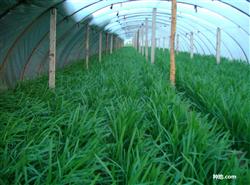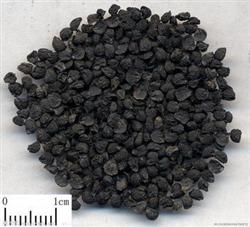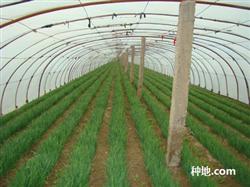How to grow leek without pollution

How to plant pollution-free leek? We should pay attention to what leek cultivation in the open field should first cultivate root plants, which can be cultivated by direct seeding or seedling cultivation. At present, seedling raising is adopted in most parts of China, and leek occupies less land at seedling stage, is easy to manage, has few grass damage, strong root plant and long life span. ① to cultivate strong seedlings: when raising seedlings in the seedbed, the seedbed should be selected in the highly dry land where drought can be irrigated, waterlogged and drained, and leeward facing the sun, and the soil where cotton, onion and garlic vegetables have not been planted in 3-4 years, and the application of high-quality rotten organic fertilizer 60000-75000kg / ha, calcium superphosphate 600kg / ha, plant ash 1500 kg / ha or combined application of nitrogen, phosphorus and potassium compound fertilizer 750kg / ha. After fertilizing, turn 20cm to 25cm deep, rake fine and level out to make beds. Sunny day and 2 days before sowing were selected to improve germination rate and germination potential. Select leek varieties with good quality, high yield, disease and insect resistance, strong stress resistance, wide adaptability and good commodity, such as 791, Pingjiu 2, Shouguang Ma Jie, Hanzhong winter leek, Beijing iron wire seedling, Hangzhou snow leek, Shanhaiguan iron wire seedling and so on. The seeds were soaked in 55 ℃ warm water for 10 minutes or in carbendazim solution for 30 minutes. The sterilized seeds were washed with clean water, soaked in 30 ℃ warm water for 24 hours, moisturized and germinated, and sowed after 2-3 days. When seedlings emerge 10-15 days after sowing, watering, topdressing, weeding and pest control should be done in time. It takes about 60 days to raise seedlings in seedling bed, during which the combination of watering and topdressing is suitable for 2 times, each time with 150 kg / ha urea or 150 kg / ha diammonium phosphate. The seedlings have 7-9 leaves and should be planted when the plant height is 18-20 cm. ② re-application of base fertilizer, timely planting: although leek has strong adaptability to the soil, but the production of pollution-free leek products have strict requirements on the soil environment. The land which is 1000-2000 meters away from the pollution source and has not planted cotton, onion and garlic vegetables in 3-4 years should be selected. it is best to plant cabbage, spring cauliflower or harvest cabbage in the previous crop. After the previous crop is harvested, the garden field should be cleaned in time, shallow ploughing and raking fine. It is better to grow leek in the open field with a length of not less than 150 meters from east to west. Wind barriers should be set up in the north. Both the wind barrier and the field bed should go east-west. After the border is done, apply fully mature high-quality organic fertilizer 60000-75000kg / ha, diammonium phosphate 300kg / ha, plant ash 1500 kg / ha, spread and turn the land evenly, mix the soil and fertilizer and rake the border surface. It is suitable to plant 3 million ~ 4.5 million plants per hectare. The overwintering ability and growth of leek in the coming year mainly depend on the amount of nutrients accumulated by the plant before winter, and the accumulation of nutrients depends on the growth status of leek in autumn. Therefore, fertility management should be strengthened at seedling stage. Generally, water is watered once every 5-7 days, combined with watering, available nitrogen fertilizer is applied for 2 times, urea 150 kg / ha or diammonium phosphate 150 kg / ha each time, and 15000 kg / ha of dung dilute water is irrigated at last. Before overwintering, it is mainly to grow roots and cultivate trees, laying the foundation for the next spring harvest. After warming up in the spring of the next year, a layer of rotten organic fertilizer can be sprinkled on the border surface of about 750kg / ha. The old root leek for more than two years should also be covered with soil of about 2 centimeters. Measures such as root picking, pinch tightening and soil cultivation can also be taken under certain conditions, which can increase ground temperature, sun dead leek maggots, loosen soil, promote root growth, and prevent lodging and rotting roots. If you do not apply fertilizer in winter, you should re-apply soil fertilizer in spring, apply rotten soil fertilizer 22500 kg / ha, sprinkle on the border surface 1-2 cm, in order to facilitate leek jumping roots. Generally do not water after fertilization in spring, if the weather is dry, you can water after the seedling height of 10 centimeters, do not apply fertilizer with water, especially do not apply quick-acting nitrogen fertilizer. If there is more rain and snow in winter and the soil moisture is better, you can also start watering after the first harvest, and loosen the soil in time to preserve soil moisture. Appropriate topdressing should be applied when new leaves grow 3-4 days after each harvest, and compound fertilizer 150 kg / ha or high-quality rotten organic fertilizer 15000-22500 kg / ha. At high temperature in summer, the tissue fiber of leaves increases, the texture is rough, and the growth weakens and shows the phenomenon of rest. Generally, it is no longer harvested. Root plant culture should continue to be strengthened to lay a good foundation for autumn production. For perennial leek, we should control water and fertilizer, prevent diseases and pests and control weeds. Autumn has a cool climate and a large temperature difference between day and night, which is the most suitable season for the growth of leek and the best time to cultivate roots. During this period, physiological activities were the strongest, especially from the Beginning of Autumn to the Autumn Equinox to re-apply fertilizer and water to promote their exuberant growth. Before and after the Beginning of Autumn, before and after applying high-quality rotten manure 15000kg / ha or soybean cake 7500 kg / ha or diammonium phosphate 600kg / ha, zinc sulfate 15kg / ha, watering once at intervals of 5-7 days, continuous watering for 3 times, topdressing for 3 times. Under suitable conditions, plant ash can be applied only once, 1500kg / ha to 2250kg / ha. It was harvested twice between late August and late September. After entering October, we should stop watering and topdressing, make use of drought to control the greedy green growth of leek, force the nutrition to transfer to the bulb and root system, and ensure safe overwintering. Click for more leek planting techniques click to see more vegetable planting techniques
- Prev

How to sow leek seeds
How to sow leek seeds? What leek seed planting methods should be paid attention to: 1. Sowing time: the Autumn Equinox can sow seeds at any time after the soil is thawed, generally from late March to early May, with spring sowing and summer sowing sooner rather than later. 2. Sowing rate: 4Mel 5kg for every 667 square meters. Raise seedlings in the open field.
- Next

Why is the leek dead?
How to fertilize leek? Should pay attention to what leek fertilizer demand is mainly nitrogen fertilizer, with the right amount of phosphorus, potassium fertilizer. Only when the nitrogen fertilizer is sufficient, the leaves can be fat and tender, and the nitrogen absorption is higher than that of other vegetables, but too much nitrogen is easy to cause leek lodging. The application of potassium fertilizer can promote cell division and swelling.
Related
- Where is it suitable to grow horseradish in China? it is expected to see the middle altitude horseradish in Alishan.
- How to prevent tomato virus disease reasonably? (Control methods included)
- Many people like to plant towel gourd on the balcony. What are the main points of this method and management?
- What crops can chili peppers be mixed with?
- Fertilization techniques and matters needing attention in Tomato
- What are the grafting techniques for peach seedlings in spring?
- Harm and control methods of root swelling disease of Chinese cabbage
- What are the pests of sweet potatoes? How to prevent and cure it?
- Symptoms, causes and Control methods of navel Rot in Tomato
- The cause of "Cucumber rotten bibcock" in Farmers' planting Cucumber and its Control Plan

